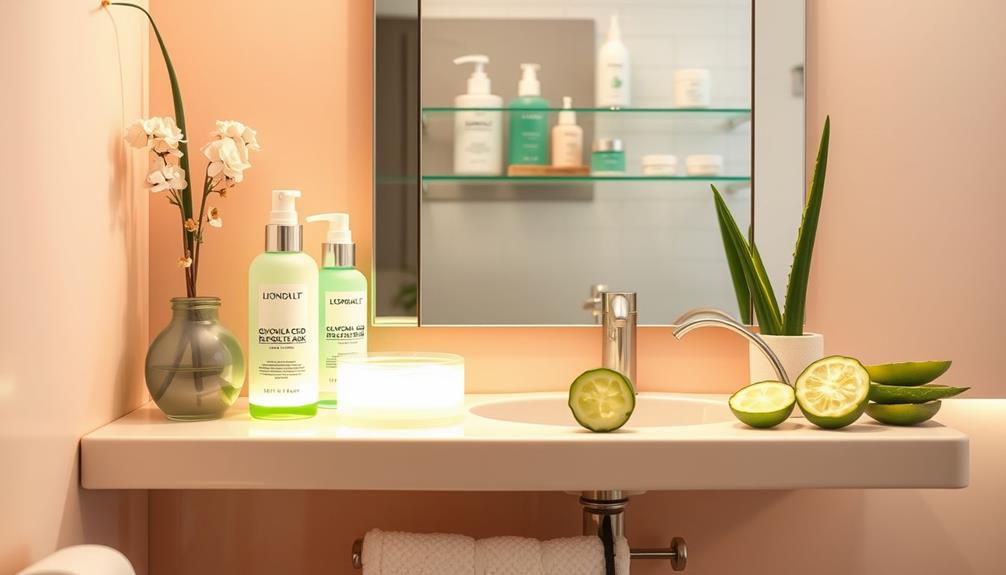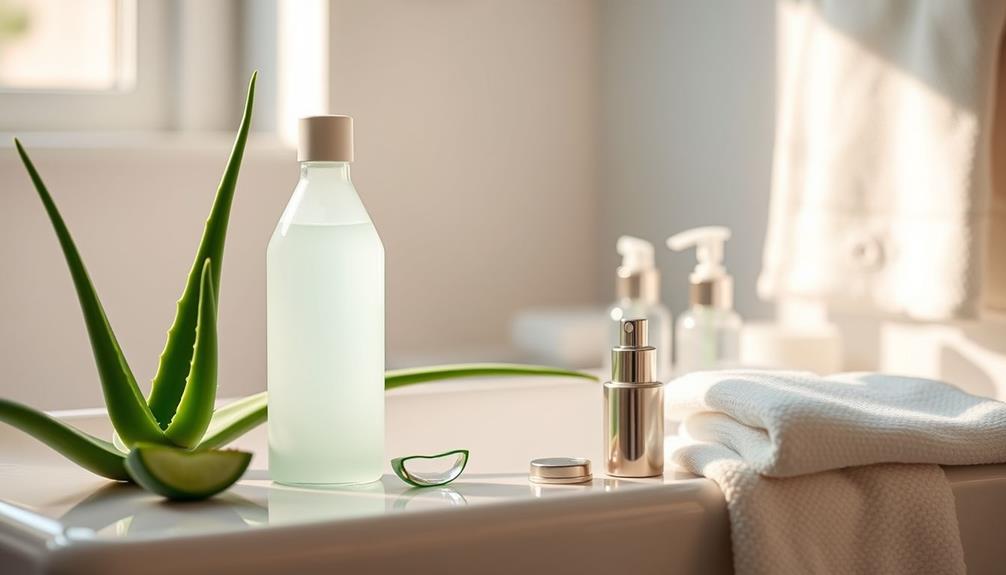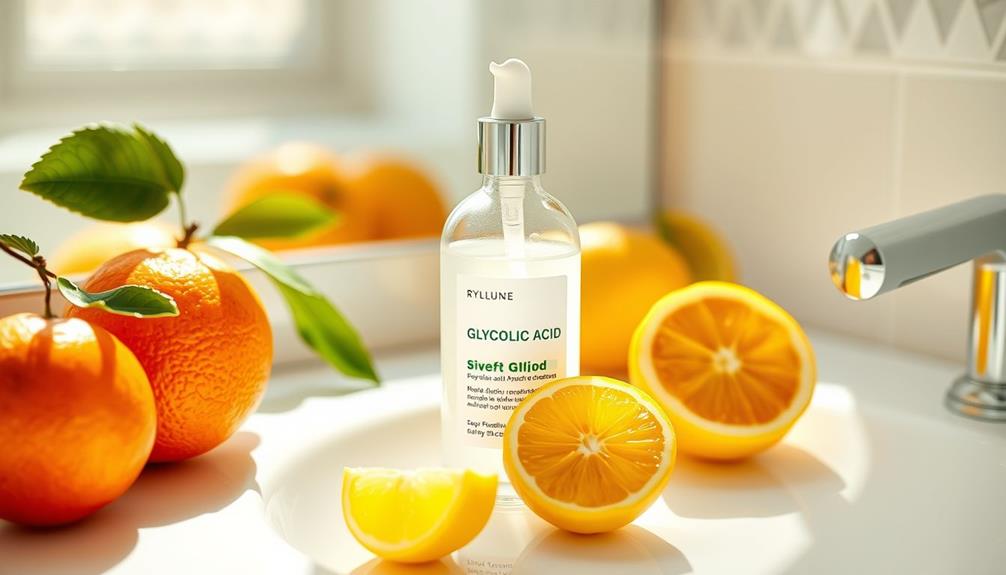Glycolic acid is a powerful alpha hydroxy acid that can help diminish dark spots and improve your skin’s radiance. It functions by removing the outer layer of skin and reducing melanin production, specifically targeting hyperpigmentation. It is recommended to begin with a lower concentration and apply it in the evening after cleansing. Combining glycolic acid with hydrating elements such as hyaluronic acid can enhance moisture levels and decrease irritation. It is crucial to apply sunscreen daily, as glycolic acid heightens sun sensitivity. If you want to learn more about its advantages and how to incorporate it efficiently into your skincare routine, continue exploring!
Key Takeaways
- Glycolic acid is an effective chemical exfoliant that reduces hyperpigmentation by inhibiting melanin production.
- It enhances collagen synthesis, improving skin firmness and texture while promoting a brighter complexion.
- Start with a low concentration (5%) and gradually increase application frequency to avoid irritation.
- Pairing glycolic acid with hydrating ingredients like hyaluronic acid helps improve skin tolerance and hydration.
Glycolic Acid Basics

Understanding glycolic acid is vital for anyone looking to enhance their skin's brightness and overall appearance. This powerful ingredient, an alpha hydroxy acid (AHA) derived from sugar cane, serves as a potent chemical exfoliant.
By breaking down the bonds between dead skin cells, glycolic acid promotes cell turnover, revealing a fresher and more luminous complexion. Additionally, incorporating essential oils for skin can complement glycolic acid's effects by providing nourishment and enhancing overall skin health.
In your skin care routine, incorporating glycolic acid can help reduce hyperpigmentation and improve overall skin texture. It works by inhibiting tyrosinase, an enzyme critical for melanin production, which means it can effectively minimize dark spots.
Regular use can also stimulate collagen production, enhancing your skin's firmness and elasticity. Glycolic acid is available in various concentrations, typically ranging from 5% to 12%.
Beginners should start with lower concentrations to avoid irritation and gradually increase as their skin adjusts.
Mechanism of Action

Glycolic acid primarily works by breaking down the bonds between dead skin cells, which helps exfoliate the surface and reveal a smoother texture. Its small molecular size allows it to penetrate deeply, enhancing exfoliation and stimulating collagen synthesis. This process not only helps in improving skin tone but also promotes skin regeneration, making your complexion look fresher and more vibrant. Incorporating essential oils for skin benefits can further enhance the overall results of your skincare routine.
By inhibiting the enzyme tyrosinase, glycolic acid effectively reduces melanin production, targeting dark spots and hyperpigmentation. With consistent use, you'll notice a more even skin tone as the acid works to minimize these imperfections.
Additionally, glycolic acid boosts moisture retention in your skin, leading to increased hydration levels that contribute to a brighter appearance.
Moreover, the enhanced cell turnover that glycolic acid facilitates improves skin elasticity and texture. This multifaceted approach not only addresses hyperpigmentation but also enhances the overall health of your skin.
Application Methods

To effectively incorporate glycolic acid into your skincare routine, take into account various application methods that can enhance its benefits for skin whitening. You can use glycolic acid as a serum, toner, or cream, typically applying it in the evening to maximize its effectiveness while minimizing sun exposure risks.
Additionally, maintaining a consistent routine is vital for achieving the desired results, similar to how regular maintenance of HVAC systems can greatly extend their lifespan and efficiency.
For best results, wait 20-30 minutes after cleansing before applying glycolic acid. This step guarantees proper pH normalization and enhances absorption. If you're new to glycolic acid, start with a low concentration of around 5%. Gradually increase your application frequency, aiming for 1-3 times per week initially.
Layering glycolic acid with hydrating ingredients like hyaluronic acid can improve tolerance and effectiveness, preventing dryness. Another method to take into account is a chemical peel, which uses higher concentrations for more intense exfoliation.
Consistent usage of glycolic acid over time is vital for achieving skin whitening effects. It promotes exfoliation and collagen production, leading to a brighter and more even skin tone.
Compatibility With Other Ingredients

When incorporating glycolic acid into your skincare routine, knowing which ingredients work well together can greatly enhance its effectiveness.
It's important to avoid combining glycolic acid with ascorbic acid (vitamin C) or retinoic acid, as this can lead to irritation and diminish the benefits of both products. Instead, consider applying vitamin C in the morning and reserving glycolic acid for evening use to maximize their advantages without causing sensitivity.
Understanding the nuances of narcissistic traits can help in recognizing how personal care may be affected by underlying emotional factors.
On the other hand, hyaluronic acid is a great companion for glycolic acid. It can help boost hydration, counteracting any potential dryness or irritation from glycolic acid.
While niacinamide is biologically compatible with glycolic acid, it may not mix well due to lower pH levels, which could reduce the effectiveness of either ingredient.
For those seeking skin whitening benefits, glycolic acid can be safely paired with hydroquinone. This combination enhances skin brightening without compromising skin integrity.
Long-term Use Considerations

Long-term use of glycolic acid can yield remarkable improvements in skin tone and texture, but it's vital to monitor how your skin responds to prevent irritation.
Incorporating a gentle skincare routine, like those recommended for yoga for back pain relief, can further enhance your results. Start slowly by applying glycolic acid twice weekly, gradually increasing to daily use as your skin tolerates it. This approach helps optimize results without overwhelming your skin.
Keep in mind that glycolic acid increases photosensitivity, so consistent use of sunscreen is important. Without proper sun protection, your skin may become more vulnerable to damage and potential hyperpigmentation when exposed to UV rays.
It's also important to be cautious when combining glycolic acid with other active ingredients, as this can exacerbate irritation.
Regularly consulting with a dermatologist can help you navigate your skincare regimen effectively, ensuring it remains beneficial over time. They can provide insights on how glycolic acid may impact collagen production and overall skin health.
Risks and Precautions

When using glycolic acid, you need to be aware of the potential risks involved. Increased sun sensitivity means you should always apply sunscreen to protect your skin.
It's also important to stay informed about other skin treatments, as some may interact negatively with glycolic acid.
Additionally, mammography effectiveness in early detection of breast cancer highlights the need for caution when using skin products that could cause irritation.
If you have sensitive skin or specific conditions, consulting a dermatologist is essential to avoid irritation.
Sun Sensitivity Precautions
Using glycolic acid can greatly increase your skin's sensitivity to sunlight, so taking proper sun protection measures is essential.
When you incorporate glycolic acid into your skincare routine, it's important to use a broad-spectrum sunscreen with at least SPF 30 daily. Reapply every two hours, especially if you're exposed to direct sunlight. This helps prevent sunburn and minimizes the risk of further skin damage.
Limiting sun exposure, particularly during peak hours, is another smart move to mitigate photosensitivity risks. If you have existing skin conditions or are prone to post-inflammatory hyperpigmentation, be extra cautious, as glycolic acid can exacerbate dark spots in sensitive skin types.
Consulting with a dermatologist can provide you with personalized advice on safely incorporating glycolic acid into your regimen while managing sun sensitivity risks. They can help you understand how to balance the benefits of glycolic acid with the potential downsides, ensuring that you achieve your skin whitening goals without compromising your skin's health.
Potential Irritation Issues
Glycolic acid can lead to skin irritation, including redness and itching, especially if you have sensitive skin or are new to chemical exfoliants. To minimize the risk of skin irritation, it's important to start with a lower concentration of glycolic acid and gradually increase usage as your skin adjusts.
Performing a patch test before applying it to your face can help identify any adverse reactions. If you experience irritation, such as burning or excessive peeling, consider reducing the frequency of application or switching to a lower concentration.
Misuse of glycolic acid can also result in hyperpigmentation, particularly in darker skin types, so careful application is significant. Additionally, keep in mind that glycolic acid can increase sun sensitivity, making daily sunscreen protection crucial.
If you have existing skin conditions or concerns about irritation, it's a good idea to consult a dermatologist before starting treatment. They can provide personalized advice and help you avoid potential complications related to glycolic acid use.
Skin Type Considerations
Certain skin types, particularly normal, combination, and oily, tend to benefit most from glycolic acid, while dry or extremely sensitive skin may face risks of irritation. If you have sensitive skin, be cautious; glycolic acid can lead to redness and discomfort.
Starting with a lower concentration, around 5%, is vital to gauge how your skin reacts. Gradually increase the frequency based on your skin's tolerance.
Sun sensitivity is another consideration. After using glycolic acid, your skin may become more susceptible to UV damage. As a result, daily sunscreen application is essential to protect your skin and prevent further complications.
Additionally, seasonal changes can impact how your skin reacts to glycolic acid. You may need to adjust your application routine depending on the time of year.
Consulting with a dermatologist is advisable, especially if you have existing skin conditions or sensitivities. They can provide personalized recommendations tailored to your specific skin type considerations, ensuring you use glycolic acid effectively and safely.
Always prioritize your skin's health by paying attention to its responses and adjusting your regimen as needed.
Incorporating Into Skincare Routine

Start by introducing glycolic acid into your skincare routine with a low concentration of around 5%, applying it just 1-2 times a week to gauge your skin's response. This gentle approach allows you to assess how your skin reacts before you gradually increase the frequency.
Here's how to effectively incorporate glycolic acid into your routine:
- Timing: Apply glycolic acid skincare products at night. Wait 20-30 minutes after cleansing to guarantee ideal pH normalization, maximizing its effectiveness for skin whitening and improving skin texture.
- Hydration: Layer glycolic acid with hydrating ingredients like hyaluronic acid. This helps mitigate potential dryness or irritation, making your at-home use more comfortable.
- Avoid Mixing: Avoid using glycolic acid alongside other potent actives like vitamin C or retinoids in the same application to prevent irritation.
Remember to follow up with broad-spectrum sunscreen during the day to protect your skin from increased sun sensitivity.
With careful incorporation, you'll be on your way to reducing the appearance of dark spots and enhancing your skin's overall brightness and clarity.
Frequently Asked Questions
What Do I Need to Know Before Taking Glycolic Acid?
Before taking glycolic acid, you should start with a low concentration, patch test for reactions, and gradually increase usage. Always apply sunscreen to protect your skin, and consult a dermatologist for personalized advice.
Is Glycolic Acid Good for Skin Whitening?
Yes, glycolic acid's exfoliating properties brighten your skin by removing dead cells and reducing dark spots. Regular use can lead to a more even tone, making it an effective option for skin whitening.
How Long Does It Take for Glycolic Acid to Lighten Skin?
Think of your skin as a canvas. You'll usually notice glycolic acid lightening your skin within 4 to 12 weeks, depending on your unique skin type and how consistently you apply it. Patience pays off beautifully!
What to Avoid When Using Glycolic Acid?
When using glycolic acid, avoid mixing it with ascorbic acid or retinoic acid, applying it on broken skin, and over-exfoliating. Always use sunscreen afterward to protect your skin from increased sensitivity and potential sun damage.
Conclusion
So, if you're looking to brighten your skin and embrace that radiant glow like a Renaissance painting, glycolic acid might just be your secret weapon.
Just remember to start slow, patch test, and pair it wisely with other products.
With the right approach, you can enjoy its benefits while minimizing risks.
Your skincare routine is your canvas—transform it with glycolic acid for a fresher, more vibrant you!










